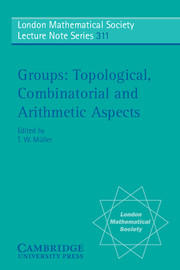Book contents
- Frontmatter
- Contents
- List of authors and participants
- Preface
- 1 Reductive groups as metric spaces
- 2 Finiteness properties of groups acting on twin buildings
- 3 Higher finiteness properties of S-arithmetic groups in the function field case I
- 4 Controlled topology and group actions
- 5 Finiteness properties of soluble S-arithmetic groups – A survey
- 6 Topology in permutation groups
- 7 Euler characteristics of discrete groups
- 8 Intersections of Magnus subgroups of one-relator groups
- 9 A minimality property of certain branch groups
- 10 Lattices with non-integral character
- 11 Some applications of probability in group theory
- 12 Parity patterns in Hecke groups and Fermat primes
- 13 Automorphisms of the binary tree: state-closed subgroups and dynamics of 1/2-endomorphisms
- 14 The mapping class group of the twice punctured torus
- 15 Kac–Moody groups: split and relative theories. Lattices
- 16 On the finite images of infinite groups
- 17 Pseudo-finite generalized triangle groups
11 - Some applications of probability in group theory
Published online by Cambridge University Press: 04 November 2009
- Frontmatter
- Contents
- List of authors and participants
- Preface
- 1 Reductive groups as metric spaces
- 2 Finiteness properties of groups acting on twin buildings
- 3 Higher finiteness properties of S-arithmetic groups in the function field case I
- 4 Controlled topology and group actions
- 5 Finiteness properties of soluble S-arithmetic groups – A survey
- 6 Topology in permutation groups
- 7 Euler characteristics of discrete groups
- 8 Intersections of Magnus subgroups of one-relator groups
- 9 A minimality property of certain branch groups
- 10 Lattices with non-integral character
- 11 Some applications of probability in group theory
- 12 Parity patterns in Hecke groups and Fermat primes
- 13 Automorphisms of the binary tree: state-closed subgroups and dynamics of 1/2-endomorphisms
- 14 The mapping class group of the twice punctured torus
- 15 Kac–Moody groups: split and relative theories. Lattices
- 16 On the finite images of infinite groups
- 17 Pseudo-finite generalized triangle groups
Summary
My aim in this article is to show how simple probabilistic arguments can be applied to prove group theoretical results. While some of these results are formulated in probabilistic language, some have purely group theoretical formulations (see Theorems 2 and 3). I am going to give only a sample of such results, referring to [Sh] for a more exhaustive survey. Not all of the results here occur in [Sh], though, and Propositions 1 and 2 have not been published before.
Our subject apparently begins with E. Netto, who, more than a century ago, wrote: “If we arbitrarily select two or more substitutions of n elements, it is to be regarded as extremely probable that the group of lowest order which contains these is the symmetric group, or at least the alternating group” [N1, p.76]. Later, in the English version of his book, he added: “In the case of two substitutions the probability in favour of the symmetric group may be as about 3/4, and in favour of the alternating, but not symmetric, group as about 1/4” [N2, p.90]. These statements were made precise by J. D. Dixon [D], who proved that, as n → ∞, the probability that two elements of Sn generate either Sn or An tends to 1. Dixon made then a generalized conjecture: let us write P(G, k) for the probability that k random elements generate the group G, then Dixon conjectured that, letting S range over all finite simple groups, P(S, 2) → 1, as |S| → ∞.
- Type
- Chapter
- Information
- GroupsTopological, Combinatorial and Arithmetic Aspects, pp. 318 - 326Publisher: Cambridge University PressPrint publication year: 2004
- 1
- Cited by



